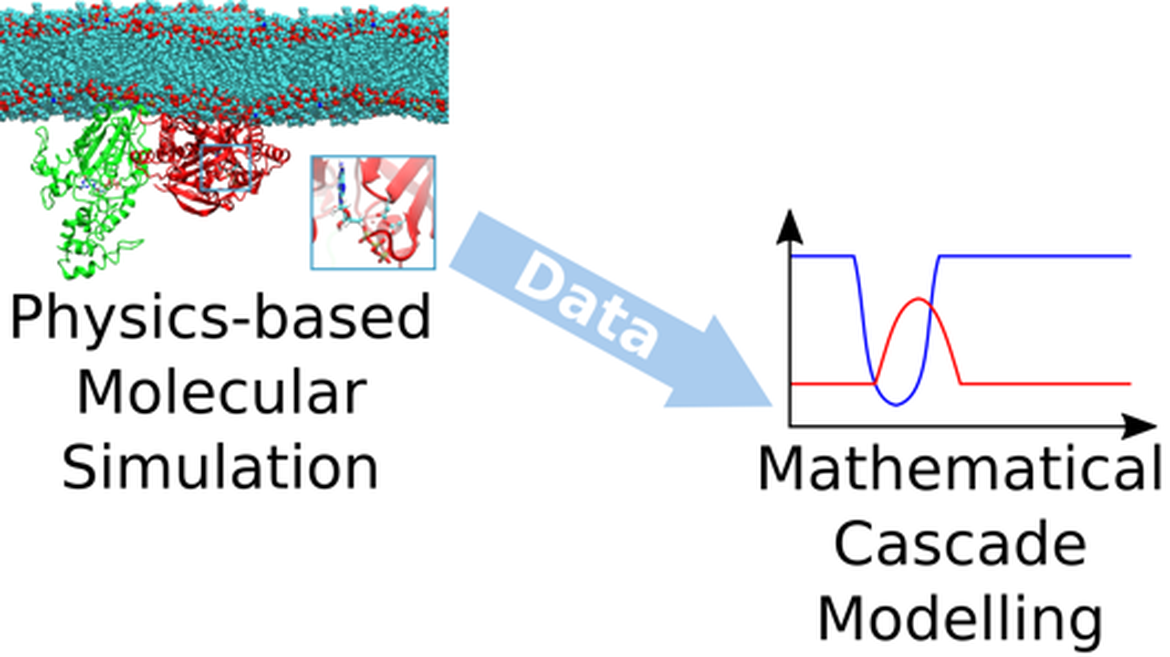Constraining Kinetic Models of Signalling Cascades using Molecular Simulation
Publications
- Bruce NJ, Narzi D, Trpevski D, van Keulen SC, Nair AG, Röthlisberger U, Wade RC, Carloni P & Hellgren Kotaleski J (2019). Regulation of adenylyl cyclase 5 in striatal neurons confers the ability to detect coincident neuromodulatory signals. PLOS Computational Biology.
______________________
 The processes that determine how a neuron responds to external chemical signals are key to understanding processes such as synaptic plasticity. Accurately modelling these processes requires simulating phenomena that occur on a wide range of spatial and temporal scales, requiring multiscale modelling approaches.
The processes that determine how a neuron responds to external chemical signals are key to understanding processes such as synaptic plasticity. Accurately modelling these processes requires simulating phenomena that occur on a wide range of spatial and temporal scales, requiring multiscale modelling approaches.
What makes modelling of molecular signalling cascades special?
Kinetic modelling of biochemical signalling networks allows us to investigate how various chemical pathways interact to control cellular processes. By simplifying the interactions between the molecules in these pathways to a set of parameterised mathematical equations that describe the changes in concentrations of various chemical species due to the chemical reactions occurring in neurons, we can build models that describe how neurons react over timescales of seconds or minutes. Often, the data needed to build these models are sparse, and the parameters in the models must be fitted in order to reproduce observed phenotypic data.
Conversely, physics-based molecular simulations allow us to build models of molecular processes from the bottom-up, requiring less assumptions in the modelling. This allows us to predict how biomolecules identify and interact with each other, the structural effects of their binding and the rates at which various reactions occur. These simulations require far more computational resources than mathematical modelling, restricting both the timescales and the number of molecules that can be simulated.
Here, we combine these two approaches. We first use physics-based simulations to obtain microscopic details of interacting biomolecules. The results of these simulations are then used to constrain higher level kinetic modelling. Notably, when more than one kinetic model can be fitted to phenotypic data, information from molecular simulations allows us to determine which model is more suitable.
What are the specific questions we are addressing in the HBP?
On the Brain Simulation Platform, we are combining workflows that use kinetic modelling to investigate biochemical process in signalling networks with molecular simulation workflows that allow us to predict the topology of these networks, along with the parameters needed to model them.
As an example case, we are taking data from molecular modelling and simulation studies of the enzyme adenylyl cyclase 5 (AC5) (see Molecular Models) and using this information to constrain a mathematical model of cAMP-dependent signalling pathways in striatal medium spiny neurons (MSNs) (see Signalling Cascades).
What is our specific take?
In our work, we are using an arsenal of bioinformatics, molecular modelling and molecular simulation techniques to obtain information on the macromolecular species present in signalling pathways. These include:
- Sequence comparisons and structural modelling to investigate protein-protein interaction networks and to predict the structures of biomolecules and the complexes they form.
- Brownian dynamics to investigate the physics of protein-protein association and make predictions of the rates at which these association processes occur.
- Molecular dynamics simulations to investigate conformational changes upon binding and the thermodynamics of binding.
- Combined quantum mechanics and molecular modelling techniques for modelling enzymatic chemical reactions.
The information obtained from these studies is then used to constrain and aid the construction of complex mathematical models of neuronal signalling.
Roadmap
In spring 2019, we released an initial cascade model, along with a preprint describing it. The full paper was published later in 2019 (Bruce et al., 2019), and a live paper has been made available, see also 'The way of making memories'. The live paper contains the data and the kinetic model for this work and is supported by several Use-cases on the Brain Simulation Platform that guide the user through some of the computational procedures for this work.
Who's involved?
The following people and their teams are driving this effort:
Jeanette Hellgren Kotaleski, KTH Royal Institute of Technology, Stockholm.
Daniel Trpevski, KTH Royal Institute of Technology, Stockholm.
Rebecca Wade, Heidelberg Institute for Theoretical Studies.
Ursula Röthlisberger, École Polytechnique Fédérale de Lausanne.
Siri van Keulen, Utrecht University.
Paolo Carloni, Forschungszentrum Jülich.
Benefit to the Community
- Our raw simulation data are available via our Live Paper in the Brain Simulation Platform, allowing researchers to further analyse these in their own work.
- We have made the models that we have built available via the Brain Simulation Platform, and other publicly available databases.



